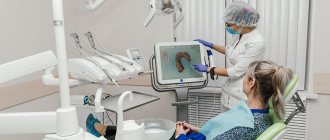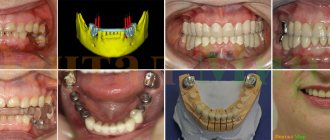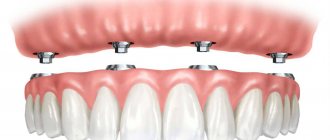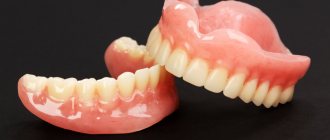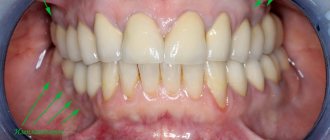Content
hide
1 What are dentures made of?
2 Materials for dentures, their types and features, strengths and weaknesses. 2.1 - Composite
2.2 - Ceramics
2.3 - Metal ceramics
2.4 - Oxide, zirconium dioxide
2.5 - Metal alloys
2.6 - Plastic (acrylic, nylon)
3 Which material is better for prosthetics?
Dentures are a way to replace destroyed dental tissues, restore the usual volume of the jaw, its aesthetic and functional parameters. Loss of teeth leads to consequences such as distortion of speech, decreased quality of digestion, and degenerative processes in bone tissue, which are associated with a decrease in mechanical load on certain areas of the jaw. There are a large number of modern materials that are used in dentistry for prosthetics. How to choose dentures and not get confused in a wide range of materials? More expensive options do not always have a significant advantage for a specific clinical situation - each prosthesis has its own characteristics.
Denture: what is it?
Dental structures inserted in place of lost teeth, partially or completely replacing the dentition, are called dentures.
They can be made from a variety of materials, can be attached to the jaw in a variety of ways, and vary in cost. Well-chosen and professionally installed dentures will return a beautiful, charming smile and solve the problem of chewing food. The use of innovative technologies and materials gives modern dentures undeniable advantages:
- comfortable to wear
- Microorganisms do not multiply on them
- light weight
- closes less of the mouth
- look natural
- reliable fixation, all models can be left overnight
Features of fiberglass pins
- High strength (1000 MPa), comparable to titanium.
- The elastic modulus of 35 GPa is close to that of natural dentin.
Thanks to a natural combination with hard tissues and modern composite materials for fixation, such pins are characterized by a long service life and high strength. Another reason for this is the uniform distribution of the chewing load throughout the entire tooth root. Due to the elasticity of the fiberglass pin, comparable to tooth tissue, the risk of mechanical destruction is minimal.
Which dentures are best to install?
Today, dentists can offer a variety of designs from various materials; in addition, dentures can be made in both fixed and removable versions.
The choice of design and material for the manufacture of prostheses suitable for the patient is chosen by the orthopedic surgeon, based on individual indications, the presence of allergic reactions to prosthetic materials and other details revealed during examination and anamnesis.
How long ago were the teeth removed?
Many people are interested in the question of when they can start dental prosthetics after extraction. It’s not easy to answer unequivocally - it all depends on individual characteristics. The average time frame is after 3–6 months, during which time you can undergo a course of treatment if necessary according to indications.
Selection of implant system
To compare dental implants, two main characteristics are taken: the cost of the product and the time frame for survival.
If we talk about economy and premium class implants, the former are inferior to the latter in terms of engraftment speed. This significantly reduces the time required for engraftment, and therefore the entire course of treatment.
Nobel Biocare, Osstem (Korea), AB, and Xive also occupy leading positions in the global market for implantation systems.
Choosing an implantation technique
Among the types of dental implantation that exist today, the most suitable one for a particular patient is selected, taking into account his individual characteristics, wishes and capabilities.
- Intraosseous implantation The implant is fixed directly into the bone tissue. Currently, the technique is recognized as the most effective of all known.
- One-stage implantation One visit is enough to install the implant and temporary crown: this is a type of classic intraosseous implantation, carried out in one stage
From several methods known in modern dentistry, the attending physician will recommend choosing the one that best suits the indications for each patient. Moreover, it is necessary to take into account, in addition to individual characteristics, indications and contraindications for the use of a particular method in each specific situation.
Main categories
What is a denture? It is an artificial implant that replaces living bone. They are divided into the following types: removable, non-removable and partially removable. To choose the right one, it is necessary to diagnose dental damage and determine the method of treatment.
Only a dentist can prescribe certain actions (operations) in the oral cavity. Self-medication is more likely to only cause harm and cause the situation to worsen.
Filmed
Used after the loss of a large number of living teeth. The main feature of such prostheses is the ability to take them off and put them on yourself at home.
This type of prosthetics solves two problems:
- Restores a section of a row - an acrylic or nylon implant is fixed to living supporting teeth (important requirements for the constituent components: lightness and strength).
- Restores the bite in cases of complete edentia - small implants are installed in the oral cavity and serve as the basis for the movable part. Two years later, after the onset of alveolar atrophy, the entire chewing area needs to be replaced (discomfort or pain may appear).
Fixed type of dentures
- The metal-ceramic structure is expensive and durable, and in terms of aesthetic indicators it is 100% similar to the original, living units.
- The metal base is quite strong, but does not look so beautiful.
- Ceramics - looks expensive, loses in the long run.
- Zirconium dioxide is a modern component, enhanced with ceramic components (it is often used, but the human body can reject it).
- Plastic is fragile, short-lived (up to 5 years), used only for small loads, unstable color spoils aesthetics (advantage: low cost).
Fixed dentures evenly distribute pressure on the jaw, help preserve speech without defects, preserve beauty for a long time, and strengthen the resistance of the oral cavity to external damage.
The main disadvantage of this approach is expensive installation, possible painful sensations during operation, and exacerbation of allergic reactions. Before making such a choice, you should consult with a qualified dentist.
To learn everything about dental prosthetics, types and features, you can sign up for a consultation through the Dentika clinic website.
Conditionally removable
The patient can independently remove the jaw restored with such a prosthesis, or contact a dentist for these manipulations. The method is used where bridge orthopedics is powerless and there are contraindications to it.
The advantages include: ease of use, reliable fastenings, increased durability, beautiful aesthetics, elimination of any deformation.
The complexity of the installation of such systems, the high cost due to the addition of additional procedures, caring for the mechanism requires regular visits to the doctor, the clamps must be replaced every year - these are the disadvantages of this method.
Types of prosthetics
Traditionally, orthopedic dentists work using two methods of dentition restoration:
- therapeutic recovery
- dental prosthetics
When restoring the dentition, the orthopedist tries to preserve the original shape of the tooth as much as possible; this is possible when part of a tooth is lost. For this purpose, two methods are used - a dental inlay and the installation of a pin, which serves as the basis for restoring teeth.
Today there are quite a lot of dentures in use, which can differ greatly from each other. To have an idea about them, you should familiarize yourself with the main types of such prostheses.
Partially removable dentures
Instead of missing one, two or more teeth, removable dentures are inserted, which are indicated if:
- premolars and molars are lost; incisors and canines
- there is a defect in the smile area
- temporary dentures needed
Fixed dentures
Currently, there are 3 types of fixed dentures and bridges. The installation of such dentures is done “forever”, and they are fixed in place for the entire time of wearing. They are distinguished by great strength and reliability, even when compared with the most expensive removable dentures.
Fully removable
This type of dentures is called “false jaws.” During such dental prosthetics, an individual impression is first made, and then the dentures are made from special acrylic, nylon and acry-free.
This type of denture is recommended for those patients who are missing molars or need to have them removed. Sometimes patients are recommended to use a special gel for fixation, which prevents the denture from moving even during chewing, thereby preventing injury to the gums.
Removable dentures for complete absence of teeth
Absolute edentia is the loss of one or two complete rows of teeth. The issue can only be resolved by inserting removable dentures or implantation. In the second case, the effect is long-term, the patient feels more comfortable, and externally, the crowns on implants look more attractive.
However, you need to know that in 90% or more cases, when teeth have been lost for a long time, the bones atrophy due to the lack of regular chewing load. In this option, the issue of implantation without bone grafting cannot be resolved. Doctors use one-stage techniques that do not require an increase in the volume of bone tissue, as well as a method where prosthetics are performed on the third day.
Dentures for partially missing teeth
If the patient has one, two or several of his teeth left in the oral cavity, then the dentures rest on them and on the gums. This method allows you to securely secure the inserted prosthesis and distribute the load more evenly.
Dental structures of a removable type do not provide for a long period of use. The reasons for this are their inconvenience and lack of aesthetics. However, the main reason is that their fixation on the gums and supporting living teeth ends up with them bearing the main load when eating. The jawbone does not experience pressure, atrophies and sags. As a result, the removable denture will have to be replaced.
Acrylic (Plastic) dentures
Affordable and without contraindications, acrylic prostheses are the most common today. Another advantage of such structures is that there is no need to grind the teeth before installation: they are secured with special hooks.
Their use is justified if it is necessary to temporarily close the space available in the dentition due to missing teeth while a permanent dental prosthesis is being prepared. The second option when these prostheses are needed is engraftment during implantation.
Removable dentures made of nylon
Nylon is widely used for the manufacture of removable structures. The “suction” method is used for fastening, and the elasticity and resistance to stress makes such prostheses in demand among patients. Suitable for allergy sufferers.
Removable dentures “Acry-free”
Dental prostheses made from acry-free, a polymer material that does not contain acrylic, are becoming increasingly popular. It has sufficient elasticity and softness, and therefore prostheses made from it do not damage the mucous membranes. High resistance to mechanical damage allows you to wear them for up to ten years. In addition, Acry-free removable structures look quite attractive: the translucent material makes dentures less noticeable. They are ideal for allergy sufferers because they do not contain any metal elements and do not cause negative reactions.
Clasp dentures
The German word “Bugel” (arch) gives its name to partial dentures, which are an expensive, complex removable system. Clasp dentures are convenient and reliable to use. They compare favorably with their plastic counterparts in that they ensure uniform distribution of pressure on the gums and remaining teeth, while acrylic (plastic) ones load the gums and are only held in place by the teeth.
New generation of dentures without palate
The use of removable dentures has been practiced for many years, but modern models have a number of significant differences that make them more comfortable. The materials used to make the old type of structures made them rigid, while they covered most of the palate, which often caused vomiting. Today there are no such problems with dentures.
The modern market offers removable “sandwich” dentures for teeth that are fixed to the gums and held in place due to their own shape, without the use of fixing gels or adhesives. Such dental prosthetics solves all problems: no negative consequences such as vomiting or distortion of the taste of food; the appearance and quality of everyday life changes for the better.
Removable dentures on implants
Implants are titanium structures that are implanted into bone tissue and perform the function of a tooth root. They are indicated if there is nothing left of the teeth, not even the root. After engraftment, a prosthesis is attached to them, or a crown is put on.
- Screw-retained dentures. The crown is secured to the implant using a screw. If necessary, it can be removed
- With cement fixation. The crown is attached to the implant using a special aba that secures it and prevents it from being removed. This technique is more often used for prosthetic teeth that are visible when a person smiles.
- All-on-4. Four implants are implanted into the bone at different angles, after which a bridge-like structure is installed on them. Almost an analogue of this method can be the implantation of six implants (All-on-6), on which a bridge is placed. With such dental prosthetics, the load during chewing is distributed more evenly. This technique is applicable even when the bone tissue has significantly atrophied
- Dental prostheses for one-stage (basal) implantation. No major surgical intervention is required; implants are implanted into deep-lying layers of bone, making it possible to install prostheses in severely atrophied tissue. This technique allows for the installation of a crown.
- Prostheses for 2-stage implantation with delayed loading: several months (three to four, or even six months) pass before the installation of crowns after implantation. During this time, crowns are placed, which are subsequently replaced with permanent ones.
Composite
The composite is durable and has a long service life. Its only drawback is the high price. But if you need a prosthesis for life, it makes sense to resolve the issue in favor of this composition. Composite is a polymer with many additives that provide exceptional strength and make artificial teeth look like real teeth.
Prosthetics are carried out according to the following algorithm:
- A polymer composition is applied to the prepared area in layers, giving it the shape of a lost tooth;
- Each layer is dried with a special lamp.
As a result of this build-up, the tooth becomes stronger and regains its lost shape. The doctor may use a pin to strengthen the structure. The pin is installed into the remains of the tooth or directly into the root canal.
Features and types of dental prosthetics, pros and cons
If we talk about dental prosthetics, each type has its own characteristics, positive and negative sides:
- Anterior dentures should look aesthetically pleasing and be installed as quickly as possible. For this purpose, temporary structures are widely used, allowing you to choose an individually suitable color and shape of teeth.
- When premolars and molars need prosthetics, their main function – chewing food – comes to the fore. Accordingly, the structure must be durable, meet the anatomical features of this type of teeth and withstand significant loads. Modern ceramic inlays, zirconium and metal-ceramic crowns meet these requirements.
In dentures, there are several categories: partially removable, removable, conditionally removable, and fixed prosthetics.
Partially and completely removable dentures include:
- clasp
- lamellar
Conditionally removable dental prosthetics include the following prostheses:
- with screw fixation on the implant
Non-removable ones include:
- crowns
- veneers
- tabs
- Lumineers
- bridge structures
- implants
Ceramics. Metal ceramics
Ceramics for many years was considered the main material for prosthetics, despite the lack of high strength. This delicate material deteriorated over time, and prosthetics had to be started all over again. Modern ceramic and metal-ceramic prostheses have changed - they are reliable and strong.
The advantage of the material is lightness. Teeth made from it are almost not felt in the mouth. Aesthetic indicators are the best. Ceramics are used for both molars and front teeth.
When performed professionally, prosthetic structures are durable, their shade, translucency and shape are indistinguishable from natural teeth. The manufacturing process does not require much time and lengthy preparation. Treatment is carried out relatively quickly. Ceramics are suitable for patients prone to allergic reactions.
Types of materials for making prostheses
With an abundance of materials, dentists have a fairly wide choice for the production of dental prostheses. Each material has its own characteristics that allow it to be used for specific tasks.
- Acrylic (plastic). The advantage is the low price, the disadvantage is a short service life, therefore it is used for the manufacture of temporary crowns and removable dentures
- Ceramics are closest in color to tooth enamel and have a certain level of strength. Thanks to modern technologies, prosthetics have been developed from a more durable material - glass ceramics based on lithium disilicate. It serves as a material for the production of aesthetic metal-free E-Max crowns
- Metal alloys - cobalt- and nickel-chrome, alloys with gold serve as materials for the manufacture of crown frames, solid bridges and crowns without ceramic coating and clasp structures
- Zirconium. Oxide or dioxide is used, which is white in color and has great strength.
It is difficult to select the best denture from the materials offered. Almost all of them can be used on posterior or anterior teeth, premolars and molars. It all depends on the indications and individual characteristics.
Content
- Composite
- Ceramics. Metal ceramics
- Ceramic dentures
- Metal alloys
- Plastic
Modern materials for prosthetics help facilitate this process. Today, dentures are high quality structures that are barely distinguishable from real teeth and are comfortable to wear. They are made from various materials.
Modern prostheses:
- High quality;
- Wearable, with a long service life;
- Aesthetic;
- Ensuring the full functioning of the dental system.
Each of the materials from which dentures are made has its own characteristics.
This group includes:
- Ceramics;
- Metal ceramics;
- Plastic;
- Composites;
- Metal alloys.
The choice of the optimal option is carried out taking into account many factors.
PROMOTION
All-on-4 prosthetics turnkey!
120,000 rub.
Technology and methods of prosthetics
Innovative technologies are also coming to dental orthopedics. The emergence of new materials and techniques allows for high-quality diagnostics (computed tomography, 3D modeling of future structures, etc.). From the initial examination to the stage of installation of dental prostheses, the orthopedic dentist has the opportunity to use the latest achievements of science. Today it has become possible in practice to manufacture high-precision durable orthopedic structures made of ceramics using milling machines using 3D models.
For all types of dental prosthetics, laboratory stages are mandatory, although today the use of innovative materials and technologies makes it possible to install dental prosthetics in one visit to an orthopedist. In this situation, the construction is manufactured on a special machine.
Chronology of the use of core inlays in dentistry: stages
Stage 1
At first, dentists used composite core inlays for crowns, reinforced with polymer fibers. Compared to metal pins, they provoked root fractures less frequently, but had a significant aesthetic drawback - the black color of the reinforcing fiber.
The technology was also not simple, since an adhesive or primer was required, etching was performed, and adhesives were applied five times to the canal walls. An opaque layer was used to mask the black color of the pin. Despite all the disadvantages, fiber structures also have tangible advantages. In the future, they can be easily removed from the canal by drilling with a regular bur.
Stage 2
The next step is white reinforcing fiber. The material began to be used for the manufacture of bridges and reinforced composite crowns. This technology has taken root in dental laboratories and moved away to orthopedic dentistry clinics. However, today it has nevertheless found application in periodontics and orthodontics - for splinting teeth.
Stage 3
With the advent of fiberglass pins manufactured on specialized lines, it has become possible to install reliable stump inlays. These materials are widely used in the military and space industries due to their lightness, strength, ductility, elasticity and ability to withstand loads for a long time.
The structure of the fiberglass pin approaches the flexibility and strength of natural tooth tissue. Therefore, using the material it is possible to create monolithic structures with a long period of operation. Such pins are fixed using durable adhesive composite materials.
Preparation for prosthetics
Before proceeding with the manufacture and installation of dentures, it is necessary to carry out thorough preliminary preparation. If during the initial examination the doctor reveals diseases of the teeth, gums or other problems with the oral cavity, then you will need to undergo a mandatory course of therapeutic treatment. Also, regardless of the planned type of dentures, you should have your teeth professionally cleaned. If a patient requires microprosthetics using lumineers or veneers to improve their appearance, they will need to undergo whitening procedures in addition to cleaning. The presence of malocclusion and lack of space for implantation may require a course of orthodontic treatment.
Care and storage
Dentures must be periodically removed from the mouth and cleaned. It's great if you do this every time after eating, but if this is not possible, you can rinse them in the morning and evening. Full dentures can be left in your mouth overnight, but it is best to remove them to give your gums a rest. In this case, before putting it in a special box, you need to thoroughly clean the prosthesis - rinse with boiled water, treat with an antiseptic solution or brush. It is recommended to have it professionally cleaned twice a year.
There is an opinion that the prosthesis should be stored in water or in a special solution. This is not so - a similar method was suitable for rubber prostheses, but modern technologies have made it possible to move away from it. Now it is enough to wrap the prosthesis in a cotton cloth and put it in a special box, where it will be protected from the sun, mechanical damage, heat and chemical influences.
Timing of prosthetics
It is impossible to talk about the exact timing of the installation of dentures: it depends on the type of prosthetics and the need to take a break between the main stages of dentures.
Regardless of the intended type of prosthetics - removable or fixed - the design is made by a dental technician in the laboratory using previously made impressions of the patient. Before placing the prosthesis in place, the patient will have to visit the doctor at least three times. At the first examination, you need to diagnose, prescribe treatment if necessary, and make an impression. At the following appointments, the prostheses are fitted and adjusted.
More time will be needed when installing implants, because it is necessary for the artificial root to take root, after which only a permanent crown can be installed. This can take from three to four months to six months.
Dental restoration with composite materials.
Dentistry is actively developing every year; people’s eternal desire for everything beautiful has motivated specialists to create new, more advanced technologies for dental treatment and restoration. Over time, a new direction called aesthetic dentistry has emerged, which deals with these issues. It provides the opportunity to correct various cosmetic defects, and composite materials allow you to recreate the structure of the tooth, its anatomical shape and color. If filling only restores the functionality of the unit, then during its restoration the appearance is corrected. Let's talk in more detail about this unique technique.
Duration of operation of different types of crowns
The most short-lived structures are made of metal-plastic. Therefore, they are traditionally used as temporary crowns. The maximum service life of products is 5 years. According to patient reviews, over time the plastic coating deforms and darkens.
Metal-ceramics is a practical option that is installed on both the front and chewing teeth. Such structures last up to 10 years.
Crowns made of medical porcelain do not darken or fade and can last up to 10-15 years. Throughout this period, the product looks like a natural tooth.
Crowns made of zirconium dioxide are considered even more stable: their service life is 15-20 years.
Prostheses made from precious metal alloys and products made from nickel are also durable and can last up to 15 years.
The service life of different types of crowns depends not only on the material, but also on the accuracy of installation. There should be no voids or gaps under a well-fixed crown. Otherwise, food debris will accumulate under the product, which over time will lead to the development of an inflammatory prosthesis.
Alternatives to a Dental Crown
Veneers are often preferred to crowns in the smile area. However, in this case, the back side of the elements should be more or less preserved.
Teeth can be restored using filling materials. This method can only be used if the destruction of the unit is not so global (less than half).
Judging by the reviews of doctors and patients, crowns are considered the optimal solution for significant damage to teeth, since they not only restore the functionality and aesthetics of a row, but also protect teeth from further destruction. An additional bonus of this type of prosthetics is the variability of materials and, accordingly, the cost of services.
Recommendations for care.
As soon as the specialist completes his work, you will be able to admire your irresistible smile, without any cosmetic defects. To maintain the results obtained for many years, you must follow a few simple rules. Their implementation will not be difficult for you at all, but at the same time your teeth will remain intact.
- Eliminate food and drinks containing dyes from your diet for a day after the procedure. In the future, also try to avoid consuming highly colored foods, carbonated water, red wine, coffee, etc.
- Don't forget about regular dental checkups and professional oral hygiene.
- On the first day after restoration, women should not wear bright red lipstick.
- The restored areas of the teeth may not withstand heavy loads, so you should not bite seeds, nuts, or chew sticky food.
- Use a toothbrush with soft bristles; it will avoid rapid abrasion of the filling material.
Crowns made of zirconium dioxide and aluminum
Until relatively recently, metal-ceramics and ceramics were considered the most common material for dental crowns in prosthetics from an aesthetic point of view.
Crowns for teeth
Currently, they have been replaced by zirconium and aluminum dioxides, which combine such positive qualities of the prosthesis as strength, excellent aesthetics, hypoallergenicity and durability. Crowns made of zirconium and aluminum dioxide can serve you faithfully for over 15 years!
The excellent aesthetics of these materials is explained by their translucency, characteristic of natural tooth enamel, as well as the absence of a metal base that can be seen through the ceramic, which allows the use of dioxides, including for prosthetics of front teeth.
Previously, these materials were not used, since there were no technologies for processing them, due to their increased strength. Today this is done using CAD/CAM technology.
Most often today, Prettau zirconium is recommended for the manufacture of prostheses from these materials, which makes it possible not to use a ceramic coating on top.
Metal-plastic crowns
Such prostheses are called conditionally temporary crowns. A cost-effective prosthetics option that involves installing crowns with a metal base and a plastic coating. Traditionally, structures are made of nickel, cobalt, and chromium.
Despite the natural appearance and relatively good functionality, it is not worth wearing such prostheses for a long time: the product quickly loses its whiteness, slightly increases in size and needs to be replaced.
Among the undeniable advantages of metal plastic are its low cost and gentle effect on the enamel layer of the tooth. If the product is slightly deformed, it can be repaired directly in the patient’s mouth. Among the disadvantages of this choice, it is worth highlighting the low strength of the structure and the likelihood of developing allergies.
